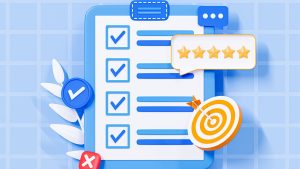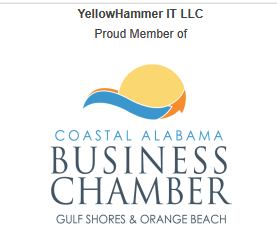Deciding on new software for your business is no small feat; it’s a complex process fraught with opportunities and pitfalls alike. Choosing the right software isn’t just a tech decision; it’s a survival skill for your business. Think of it like this: big corporations have entire IT teams to play matchmaker with software, but smaller businesses often have to make do with fewer resources. Every software choice becomes a big deal because it can either catapult you ahead or bog you down. Feeling the pressure? Don’t worry. That’s where a Managed Service Provider (MSP), like YellowHammerIT, LLC can help you make smarter, stress-free choices.
Before diving into the ocean of software solutions, you must first understand your business needs. Are you looking for CRM software, an accounting system, a project management tool, or a solution to a problem that could be handled by software you already have? Knowing what problem you’re solving will guide you in identifying the software features that are absolutely crucial for your business. Once you know what problem you are trying to solve, you are ready to explore factors to consider when choosing software.

Checklist for Vetting Software
To help you cut through the noise and make the most informed decision, we’ve compiled a comprehensive checklist. In the field of IT, choosing software is often referred to as vetting software. This is the process of conducting an in-depth evaluation of a software solution before acquiring or implementing it. The goal of vetting software before purchasing is to ensure that the software meets your organization’s requirements, including functionality, security, scalability, and cost-effectiveness. Essentially, you’re checking to see if the software does what it claims to do, whether it fits your business needs, and if it complies with relevant regulations and standards. Whether you’re a first-timer or a seasoned pro looking to update your tech stack, this checklist is your roadmap to a successful software acquisition.
Costs
Look Beyond the Price Tag
When it comes to evaluating software, the initial purchase price is just the tip of the financial iceberg. A more accurate measure is the Total Cost of Ownership (TCO), which includes a variety of hidden or ongoing costs that can accrue over the lifetime of the software. Here’s how to scrutinize costs more thoroughly:
Subscription Fees
If the software is subscription-based, consider the long-term costs. A low monthly fee may look attractive but could add up significantly over time. Also, understand what is included and excluded in the subscription fee to avoid any surprise costs down the road.
Licensing Models
Understand the software’s licensing model. Is it per user, per device, or based on features? Knowing this can help you plan your budget more accurately and choose a model that offers the best value for your specific needs.
Implementation Costs
Setting up the software often involves various one-time costs like hardware upgrades, data migration, or staff training. Make sure to account for these in your budget.
Customization Costs
Some businesses may require software customization to meet their specific needs. Customization can be expensive, and it’s crucial to include these costs in your TCO calculation.
Integration Costs
If you’re planning to integrate the new software with existing systems, there may be additional costs involved, either for third-party apps or specialized services to achieve the integration.
Support and Maintenance
While some vendors include basic support and maintenance in the initial purchase price or subscription fee, others may charge extra for premium support levels, software updates, or even bug fixes.
Exit Costs
Have you ever heard the saying, “They’ll get you coming and going.” Well, some software vendors will charge you coming and going! What if you eventually need to switch to a different software solution? Data export fees, employee retraining, and other associated switch-over costs can be significant and should be considered in your TCO analysis.
Scalability Costs
As your business grows, your software needs may grow too. Be aware of the cost implications of adding more users, data storage, or features as covered in the “scalability” factor. Some software vendors use the Foot-in-the-Door sales and pricing model, which means they will get you in with low prices and then significantly upcharge when you need to add on additional features.
Currency Fluctuations
If you’re dealing with international vendors, be mindful of currency exchange rates, as they can impact the actual cost you end up paying.
Usability
The Human Factor of Software Adoption
An intuitive, user-friendly interface isn’t just a ‘nice-to-have’ feature; it’s a crucial factor in the successful implementation and ongoing usage of any software solution. Poor usability can lead to reduced productivity, increased error rates, and ultimately, frustrated employees. Here’s how to dig deeper into a software’s usability:
User Experience (UX) Design
Look for software that prioritizes a clean, simple design where core functions are easily accessible. Good UX design enhances user adoption and can make the learning curve for your team considerably shorter.
Demo or Trial Period
Take advantage of demo versions or trial periods to let your employees interact with the software. Their feedback can offer invaluable insights into how easy or difficult they find the software to use.
Onboarding Features
Check if the software includes onboarding features like tutorials, tooltips, or a guided setup process. These elements can help new users become proficient more quickly.
Task Flows
Evaluate how many clicks or steps are required for common tasks. The fewer actions needed, the better the software’s usability, generally speaking.
Customizability
Does the interface allow for customization to fit your specific business processes? Being able to tailor the software to your needs can significantly improve usability.
Accessibility
Check if the software offers features to make it accessible to users with disabilities. Not only is this ethically responsible, but it can also be a legal requirement in some jurisdictions.
Mobile Responsiveness
In our increasingly mobile world, ensure the software is usable on various devices, especially if your workforce is remote or frequently on-the-go.
Language Support
If your team or customer base is multilingual, check if the software supports multiple languages.
Compatibility
The Glue That Binds Your Tech Stack
In a perfect world, every software system would work seamlessly with the others, but the reality is often far from it. Compatibility issues can lead to decreased productivity, increased operational costs, and a host of other challenges. That’s why it’s essential to make sure that any new software you adopt can peacefully coexist with your existing tech stack. Here’s how to delve deeper into compatibility considerations:
Operating System Requirements
Check what operating systems the software supports and ensure it aligns with what your organization uses. This includes not just desktop systems but also mobile OS if your team works on the go.
API Availability
Does the software offer an API (Application Programming Interface) for custom integrations? An API can be a lifesaver when you need the new software to interact with existing applications.
Data Format Compatibility
Examine if the software can handle the data formats your existing systems use. Whether it’s a particular spreadsheet format, SQL databases, or JSON files, data format compatibility will make transitions smoother.
Network Requirements
Review the software’s network requirements, particularly if you’re operating in a specialized or restricted network environment. Make sure it won’t strain your network’s bandwidth or require ports that you prefer to keep closed for security reasons.
Hardware Constraints
Look into any hardware constraints the software might have. For instance, does it require a certain amount of RAM, a specific processor speed, or other hardware components that your current systems may not possess?
Third-party Integrations
Many modern software solutions offer built-in integrations with popular third-party applications. Check if the new software integrates with the tools you’re already using, like CRM systems, email platforms, or accounting software.
Legacy Systems
If your organization uses older, legacy systems, compatibility can become even more critical. Ensure the new software can either integrate with these systems or that you have a migration plan in place.
User Access
Consider how your team will access the software. Is it cloud-based, requiring only a browser, or does it need to be installed on individual machines? Make sure this is feasible within your existing tech environment.
Scalability
Growing With Your Business
The scalability of a software solution is a critical consideration, especially for small to medium-sized businesses with ambitions to grow. Simply put, scalability refers to the software’s ability to handle increased workloads, more users, and additional features without negatively affecting performance. It’s about the software’s flexibility to adapt to your evolving needs over time. Here’s how to dig deeper into the scalability aspect while vetting software:
User Capacity
Check if the software can handle more users as your team grows. Some software solutions have a maximum user limit or require you to move to a more expensive tier when you add more users. Knowing this in advance can help you budget accordingly.
Feature Expandability
As your business grows, your functional requirements might change. You might need new modules or features that you didn’t initially consider. Ensure the software either offers these additional features or supports third-party integrations that can add those features.
Performance Under Load
Some software works well with small volumes of data but becomes sluggish as data piles up. It’s essential to know how the software performs under increased workloads. Ask the vendor for performance metrics or case studies that detail how the software performs under high stress or request a scalability test.
Cost of Scaling
More users and features often mean more costs. Understanding the cost implications of scaling is vital. Are there financial penalties for exceeding certain limits? Does the cost per user decrease as you add more users, or does it remain the same?
System Architecture
The software’s architecture can also impact its scalability. For example, cloud-based software usually offers better scalability than on-premises solutions, as cloud providers can quickly add resources as needed.
Future-Proofing
Technology evolves rapidly. While you’re assessing a software’s scalability, consider its track record for adopting new technologies and trends. Software that is slow to adapt may not meet your needs in the long run.
Vendor Support for Scaling
Hidden Costs
Consider the vendor’s role in helping you scale. Do they offer consultation and support services for scaling? Are there any extra costs associated with this?
Security
A Non-Negotiable Priority
The importance of robust software security cannot be overstated. Failing to properly vet a software’s security measures can expose your business to risks ranging from data breaches to legal repercussions. However, ensuring that a software solution is secure involves more than just ticking off a checklist of security features. Here’s how to deepen your scrutiny:
Encryption Standards
Look into the encryption standards the software employs for both data-at-rest and data-in-transit. Strong encryption is a must-have to protect sensitive data.
Access Controls
Examine the software’s capabilities in terms of role-based access controls. Being able to restrict who can access what can go a long way in preventing unauthorized access and data leaks.
Multi-Factor Authentication (MFA)
Inquire if the software supports multi-factor authentication, which adds an extra layer of security by requiring two or more verification methods—a password, a smart card, a fingerprint, etc.
Incident Response Plan
Ask the vendor about their incident response plan in case of a security breach. How quickly will they notify you, and what steps will they take to rectify the issue?
Regular Security Audits
Does the vendor conduct regular security audits and vulnerability assessments? Transparency in these matters indicates a proactive approach to security.
Data Backups and Recovery
Understand the software’s backup and recovery protocols. In case of data loss due to any number of reasons like accidental deletion or ransomware attack, it’s crucial to know how your data will be restored and how quickly.
Compliance Certifications
Beyond just GDPR, see if the software complies with other relevant industry-specific regulations such as HIPAA for healthcare or PCI DSS for payment security. Compliance certifications can offer an additional layer of assurance.
Software Patching and Updates
Find out how frequently the vendor releases security patches and updates. Regular updates indicate an ongoing commitment to security.
Vendor’s Security Culture
Try to gauge the vendor’s overall culture around security. Do they have a dedicated security team? Are they transparent about how they handle data and security on their end?
Vendor Reputation
More Than Just a Brand Name
Vendor reputation goes beyond just brand recognition; it speaks volumes about the reliability and quality of the software, as well as the level of customer service and support you can expect. A reputable vendor is often synonymous with stability, which can be invaluable for your business continuity. Here’s how to further scrutinize the vendor’s reputation:
Customer Testimonials and Reviews
Look for customer testimonials and third-party reviews to understand how the vendor has met the needs of other businesses. Pay special attention to reviews from companies similar to yours in terms of size or industry.
Pay attention to any recurring issues or complaints that arise in reviews. While no software is perfect, consistent negative feedback on a particular aspect could be a deal-breaker.
Industry Awards and Certifications
Accolades and certifications from recognized industry bodies can be strong indicators of a vendor’s credibility and commitment to quality.
Financial Stability
Inquire about the financial health of the vendor. A financially stable vendor is more likely to be around for the long term, providing ongoing support and updates to the software.
Track Record for Updates and Innovations
Check the vendor’s history of software updates and innovations. Frequent updates suggest that the vendor is proactive about improving their product and staying current with industry trends.
Support and Maintenance Policies
A vendor’s reputation often hinges on the quality of customer support. Research their support policies, turnaround times, and the availability of resources like tutorials, FAQs, and community forums.
Ethical Considerations
In today’s socially-conscious business environment, you may also want to investigate the vendor’s reputation in terms of ethical considerations like environmental responsibility, fair labor practices, and data ethics.
Responsiveness in Pre-Sales Stage
The vendor’s behavior during the pre-sales stage often sets the tone for the ongoing relationship. Are they prompt in answering queries? Do they provide detailed and clear information? A vendor interested in understanding and meeting your specific needs is often a good sign.
Key Performance Indicators (KPIs)
Case studies often highlight specific KPIs that were improved by adopting the software. These can offer measurable outcomes to look for in your own implementation.
Version Updates
Check how the software has evolved over time. Are user complaints being addressed in new versions? This can give you a sense of how responsive the company is to customer feedback.
Support & Maintenance
Your Safety Net for the Unexpected
Even the most intuitive and reliable software can encounter issues or require specialized know-how to make the most of its features. That’s where vendor support and maintenance come into play. Not all support plans are created equal, so it’s vital to understand what’s available to you as you make your software selection. Here are some key areas to consider:
Support Channels
Identify which channels of support are available. Whether it’s live chat, email, or a dedicated phone line, knowing how you can reach out for help can influence your decision.
Response Time
Inquire about the expected response time for support queries. When a critical issue arises, every minute counts. Does the vendor offer SLAs (Service Level Agreements) that guarantee a specific response time?
Knowledge Base
Check if the vendor provides a comprehensive knowledge base, FAQs, or community forums. Self-service resources can be invaluable for resolving common issues without having to contact support.
Support Hours
Are support services available 24/7, or do they operate during specific hours? What is important to you? If your business operates across time zones or outside of regular business hours, this is an essential factor.
Maintenance Schedule
Understand how often the software is updated and what those updates entail. Regular updates are a good sign, but you’ll also want to know if they will disrupt service and for how long.
Additional Costs
As mentioned in the Cost factor, be clear about any additional costs for premium support services. Some vendors offer basic support for free but charge for more in-depth assistance or quicker response times.
Third-party Providers
If the vendor doesn’t offer robust support, are there third-party providers who do? Sometimes specialized support firms can fill in the gaps, but it’s essential to budget for this extra expense.
Legal & Compliance
Navigating the Regulatory Maze
Failing to consider the legal and compliance aspects of new software can expose your business to substantial risks, including hefty fines and legal disputes. It’s not just about ticking off boxes; it’s about sustaining your operations and reputation in a compliant manner. Here are some focal points to guide your assessment:
Data Protection Laws
Is the software compliant with data protection and privacy laws such as GDPR in Europe or CCPA in California? Non-compliance can result in severe penalties, so this is a crucial box to tick.
Industry-Specific Regulations
Different industries have their own sets of compliance guidelines, such as HIPAA in healthcare or FINRA in financial services. Make sure the software adheres to any industry-specific laws governing your business.
Auditing Features
Does the software include features that help you comply with audits? The ability to easily access and present data can save you both time and stress during an audit.
Data Storage and Sovereignty
Understand where the software stores its data and whether that aligns with data sovereignty laws applicable to your business. In some industries, storing data across borders can be a legal issue.
Terms and Conditions
Carefully review the software’s terms and conditions or end-user license agreement (EULA). Sometimes these can be scary when you carefully review them. Make sure there are no clauses that might expose you to legal risk.
Accessibility Laws
Check if the software complies with accessibility regulations such as the Americans with Disabilities Act (ADA). Failure to comply could result in litigation.
Export Controls
Be aware of any export restrictions that might apply to the software, particularly if your business operates internationally. Certain software might be subject to export controls that could limit its use in some countries.
Exit Strategy
Look into how easily you can retrieve your data and discontinue the service if needed. The easier this process is, the lower your risk in case the vendor goes out of business or you decide to switch platforms.
Legal Recourse
Understand what legal recourse is available to you if things go wrong. Are there warranties or indemnities in place? What does the dispute resolution process look like?
How an MSP Can Help with Software Selection
There is a lot to consider when making software selections. Don’t get discouraged! Consulting with a managed service provider (MSP) can be a game-changer in helping you vet software purchases for your business? Let’s see what partnering with an MSP can do for you:
Expert Recommendations Tailored to Your Business
Managed Service Providers (MSPs) bring a wealth of industry-specific knowledge and expertise to the table. They don’t just recommend popular software; they carefully analyze your unique business needs, goals, and operational constraints to suggest solutions that will offer the most value to your organization.
In-Depth Cost Analysis for Informed Decisions
The upfront price of software is just the tip of the iceberg. MSPs conduct a comprehensive total cost of ownership (TCO) analysis, which includes not only the initial purchase price but also ongoing expenses like maintenance, support, and potential upgrades. They can help identify hidden costs like those related to training, maintenance, or upgrades.
End-to-End Implementation and Staff Training
Transitioning to new software can be a disruptive process. MSPs handle the nitty-gritty details of technical implementation, from installing the software to configuring it to fit into your existing tech ecosystem. They can also provide hands-on training for your staff, ensuring everyone is comfortable and proficient with the new tools.
Rigorous Security Assessments to Keep You Compliant
MSPs take a deep dive into the security features of each software option, assessing how well they align with industry regulations and compliance standards such as GDPR, HIPAA, or other relevant laws. They can help you mitigate risks by ensuring that your chosen software adheres to best practices in cybersecurity.
Ongoing Support and Proactive Monitoring
The MSP’s role doesn’t end with implementation. They offer continuous support and regular monitoring services to ensure that your software stays updated, secure, and aligned with your evolving business needs. This ongoing relationship allows you to focus on your core business while the MSP takes care of the technical upkeep.
By leveraging the specialized skills and services of an MSP, you not only make the software selection process less overwhelming but also set yourself up for long-term success with a well-chosen, securely implemented, and effectively managed software solution. Let YellowHammerIT, LLC shoulder the burden of vetting, implementing, and managing your software acquisitions. With our expert guidance, make informed decisions that propel your business toward success.

All of your IT needs under a single pane of glass.
Take the guesswork out of software acquisition with YellowHammer IT, LLC
More Articles...

Should I Hire a Managed Service Provider? A Cost-Benefit Analysis

Why Email Security is Essential for Your Business

Logo & Branding Guide: What You Should Know
Build Courses Faster in Canvas LMS: Strategies to Boost Efficiency

Designing Accessible Pages in Canvas LMS

Enhancing Business Security with Video Cameras

Discover the Benefits of Custom Email Services

Tailored IT Services for Southern Businesses

Setting Up Your Instructional Design Shop

Rapid Course Development for Canvas LMS

Top 10 Strategies for Ad Panels: Maximizing Impact



